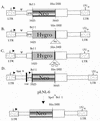Monitoring retroviral RNA dimerization in vivo via hammerhead ribozyme cleavage
- PMID: 9733882
- PMCID: PMC110209
- DOI: 10.1128/JVI.72.10.8349-8353.1998
Monitoring retroviral RNA dimerization in vivo via hammerhead ribozyme cleavage
Abstract
We have used a strategy for colocalization of Psi (Psi)-tethered ribozymes and targets to demonstrate that Psi sequences are capable of specific interaction in the cytoplasm of both packaging and nonpackaging cells. These results indicate that current in vitro dimerization models may have in vivo counterparts. The methodology used may be applied to further genetic analyses on Psi domain interactions in vivo.
Figures







Similar articles
-
Ribozyme-mediated suppression of Moloney murine leukemia virus and human immunodeficiency virus type I replication in permissive cell lines.Proc Natl Acad Sci U S A. 1994 Oct 11;91(21):9715-9. doi: 10.1073/pnas.91.21.9715. Proc Natl Acad Sci U S A. 1994. PMID: 7937878 Free PMC article.
-
Analytical study of rat retrotransposon VL30 RNA dimerization in vitro and packaging in murine leukemia virus.J Mol Biol. 1994 Jul 29;240(5):434-44. doi: 10.1006/jmbi.1994.1459. J Mol Biol. 1994. PMID: 8046749
-
Tethering ribozymes to a retroviral packaging signal for destruction of viral RNA.Science. 1993 Dec 3;262(5139):1566-9. doi: 10.1126/science.8248806. Science. 1993. PMID: 8248806
-
Ribozymes: structure and mechanism in RNA catalysis.Trends Biochem Sci. 1996 Jun;21(6):220-4. Trends Biochem Sci. 1996. PMID: 8744356 Review.
-
Ribozymes of the hepatitis delta virus: recent findings on their structure, mechanism of catalysis and possible applications.Acta Biochim Pol. 2001;48(2):409-18. Acta Biochim Pol. 2001. PMID: 11732611 Review.
Cited by
-
mRNA localization signals can enhance the intracellular effectiveness of hammerhead ribozymes.RNA. 1999 Sep;5(9):1200-9. doi: 10.1017/s1355838299990246. RNA. 1999. PMID: 10496221 Free PMC article.
-
Two distinct Moloney murine leukemia virus RNAs produced from a single locus dimerize at random.Virology. 2006 Jan 20;344(2):391-400. doi: 10.1016/j.virol.2005.09.002. Epub 2005 Oct 10. Virology. 2006. PMID: 16216294 Free PMC article.
-
Structure of an RNA switch that enforces stringent retroviral genomic RNA dimerization.Proc Natl Acad Sci U S A. 2006 Sep 12;103(37):13640-5. doi: 10.1073/pnas.0606156103. Epub 2006 Aug 31. Proc Natl Acad Sci U S A. 2006. PMID: 16945907 Free PMC article.
-
Nonrandom dimerization of murine leukemia virus genomic RNAs.J Virol. 2004 Nov;78(22):12129-39. doi: 10.1128/JVI.78.22.12129-12139.2004. J Virol. 2004. PMID: 15507599 Free PMC article.
References
-
- Alford R L, Honda S, Laurence C B, Belmont J W. RNA secondary structure analysis of the packaging signal for Moloney murine leukemia virus. Virology. 1991;183:611–619. - PubMed
-
- Awang G, Sen D. Mode of dimerization of HIV-1 genomic RNA. Biochemistry. 1993;32:11453–11457. - PubMed
-
- Bender W, Davidson N. Mapping of poly(A) sequences in the electron microscope reveals unusual structure of type C oncornavirus RNA molecules. Cell. 1976;7:595–607. - PubMed
Publication types
MeSH terms
Substances
Grants and funding
LinkOut - more resources
Full Text Sources

